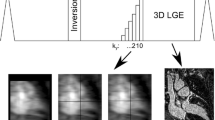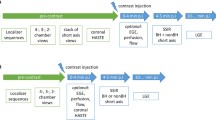Abstract
Purpose: Using segmented k-space turbo gradient echo MR techniques (TGE) contrast between blood and myocardium is often reduced in long axis views due to reduced in plane spin-refreshment, particularly in patients with low ejection fraction. The application of an intravascular contrast agent (CA) may improve endocardial border delineation. Materials and methods: In 15 patients cardiac cine loops in two long axis and two short axis views were acquired during breath hold using a TGE sequence without and with increasing doses of CA (0.75, 2.0, 5.0 mg Fe/kg). Two independent observers evaluated left ventricular function (LVEF, modified Simpson's rule) and assigned a visual score (range: 0 = ‘not visualized’ to 6 = ‘excellent visualization’) for endocardial border delineation. Signal- and contrast-to-noise ratios (SNR; CNR) were determined. Results: Endocardial border delineation score for TGE was 1.7 ± 0.6 and 3.9 ± 0.6**, 4.4 ± 0.5**, 4.6 ± 0.4** for 0.75, 2.0, 5.0 mg Fe/kg of CA, respectively ( ** p < 0.01 vs. TGE). SNR of blood increased significantly with any dose of CA with a mild drop of myocardial SNR resulting in a significant increase of CNR blood/myocardium. The maximum effect with 2.0 mg Fe/kg was a >2-fold CNR increase. Inter- and intraobserver variability assessed according to the method of Bland–Altmann was reduced at 2.0 mg Fe/kg for determination of LVEF and reached statistical significance for LVEF <50%. Conclusion: Intravascular CA increased CNR between blood and myocardium by a factor >2 and significantly improved the determination of cardiac volumes. The benefit in accuracy was most for patients with left ventricular ejection fraction <50%.
Similar content being viewed by others
References
Semelka RC, Tomei E, Wagner S, et al. Normal left ventricular dimensions and function: interstudy reproducibility of measurements with cine MR imaging. Radiology 1990; 174: 763–768.
Stratemeier EJ, Thompson R, Brady TJ, et al. Ejection fraction determination by MR imaging: comparison with left ventricular angiography. Radiology 1986; 158: 775–777.
Longmore DB, Klipstein RH, Underwood SR, et al. Dimensional accuracy of magnetic resonance in studies of the heart. Lancet 1985; 1: 1360–1362.
Baer FM, Theissen P, Schneider CA, et al. MRI assessment of myocardial viability: comparison with other imaging techniques. Rays 1999; 24: 96–108.
Nagel E, Lehmkuhl HB, Bocksch W, et al. Noninvasive diagnosis of ischemia-induced wall motion abnormalities with the use of high-dose dobutamine stress MRI: comparison with dobutamine stress echocardiography. Circulation 1999; 99: 763–770.
Nagel E, Lehmkuhl HB, Klein C, et al. Influence of image quality on the diagnostic accuracy of dobutamine stress magnetic resonance imaging in comparison with dobutamine stress echocardiography for the noninvasive detection of myocardial ischemia. Z Kardiol 1999; 88: 622–630.
Baldy C, Douek P, Croisille P, Magnin IE, Revel D, Amiel M. Automated myocardial edge detection from breath-hold cine-MR images: evaluation of left ventricular volumes and mass. Magn Reson Imaging 1994; 12: 589–598.
Singleton HR, Pohost GM. Automatic cardiac MR image segmentation using edge detection by tissue classification in pixel neighborhoods. Magn Reson Med 1997; 37: 418–424.
van Rugge FP, van der Wall EE, Spanjersberg SJ, et al. Magnetic resonance imaging during dobutamine stress for detection and localization of coronary artery disease: quantitative wall motion analysis using a modification of the centerline method. Circulation 1994; 90: 127–138.
van der Geest RJ, Lelieveldt BP, Reiber JH. Quantification of global and regional ventricular function in cardiac magnetic resonance imaging. Top Magn Reson Imaging 2000; 11: 348–358.
Matsumura K, Nakase E, Haiyama T, et al. Determination of cardiac ejection fraction and left ventricular volume: contrast-enhanced ultrafast cine MR imaging vs IV digital subtraction ventriculography. AJR Am J Roentgenol 1993; 160: 979–985.
Pennell DJ, Underwood SR, Longmore DB. Improved cine MR imaging of left ventricular wall motion with gadopentetate dimeglumine. J Magn Reson Imaging 1993; 3: 13–19.
Alley MT, Napel S, Amano Y, et al. Fast 3D cardiac cine MR imaging. J Magn Reson Imaging 1999; 9: 751–755.
Wagenseil JE, Johansson LO, Lorenz CH. Characterization of t1 relaxation and blood-myocardial contrast enhancement of NC100150 injection in cardiac MRI. J Magn Reson Imaging 1999; 10: 784–789.
Stillman AE, Wilke N, Jerosch-Herold M. Use of an intravascular T1 contrast agent to improve MR cine myocardial- bloodpool definition in man. J Magn Reson Imaging 1997; 7: 765–767.
Taylor AM, Panting JR, Keegan J, et al. Safety and preliminary findings with the intravascular contrast agent NC100150 injection for MR coronary angiography. J Magn Reson Imaging 1999; 9: 220–227.
Dulce MC, Mostbeck GH, Friese KK, Caputo GR, Higgins CB. Quantification of the left ventricular volumes and function with cine MR imaging: comparison of geometric models with three-dimensional data. Radiology 1993; 188: 371–376.
Bland JM, Altman DG. Statistical methods for assessing agreement between two methods of clinical measurement. Lancet 1986; 1: 307–310.
Bellenger NG, Davies LC, Francis JM, Coats AJ, Pennell DJ. Reduction in sample size for studies of remodeling in heart failure by the use of cardiovascular magnetic resonance. J Cardiovasc Magn Reson 2000; 2(4): 271–278.
Latson LA, Powell KA, Sturm B, Schvartzman PR, White RD. Clinical validation of an automated boundary tracking algorithm on cardiac MR images. Int J Cardiovasc Imaging 2001; 17(4): 279–286.
Barkhausen J, Ruehm SG, Goyen M, Buck T, Laub G, Debatin JF. MR evaluation of ventricular function: true fast imaging with steady-state precession versus fast low-angle shot cine MR imaging: feasibility study. Radiology 2001; 219: 264–269.
Thiele H, Paetsch I, Schnackenburg B, et al. Improved accuracy of quantitative assessment of left ventricular volume and ejection fraction by geometric models with steady-state free precession. J Cardiovasc Magn Reson 2002; 4(3): 327–339.
Taylor AM, Panting JR, Keegan J, et al. Safety and preliminary findings with the intravascular contrast agent NC100150 injection for MR coronary angiography. J Magn Reson Imaging 1999; 9(2): 220–227.
Klein C, Nagel E, Schnackenburg B, et al. The intravascular contrast agent Clariscan (NC 100150 injection) for 3D MR coronary angiography in patients with coronary artery disease. MAGMA 2000; 11(1–2): 65–67.
Stillman AE. New contrast agents for cardiovascular MRI and MRA. Int J Cardiovasc Imaging 2001; 17(6): 471–472.
Author information
Authors and Affiliations
Rights and permissions
About this article
Cite this article
Paetsch, I., Thiele, H., Schnackenburg, B. et al. Improved functional cardiac MR imaging using the intravascular contrast agent CLARISCAN™ . Int J Cardiovasc Imaging 19, 337–343 (2003). https://doi.org/10.1023/A:1025432415983
Issue Date:
DOI: https://doi.org/10.1023/A:1025432415983




